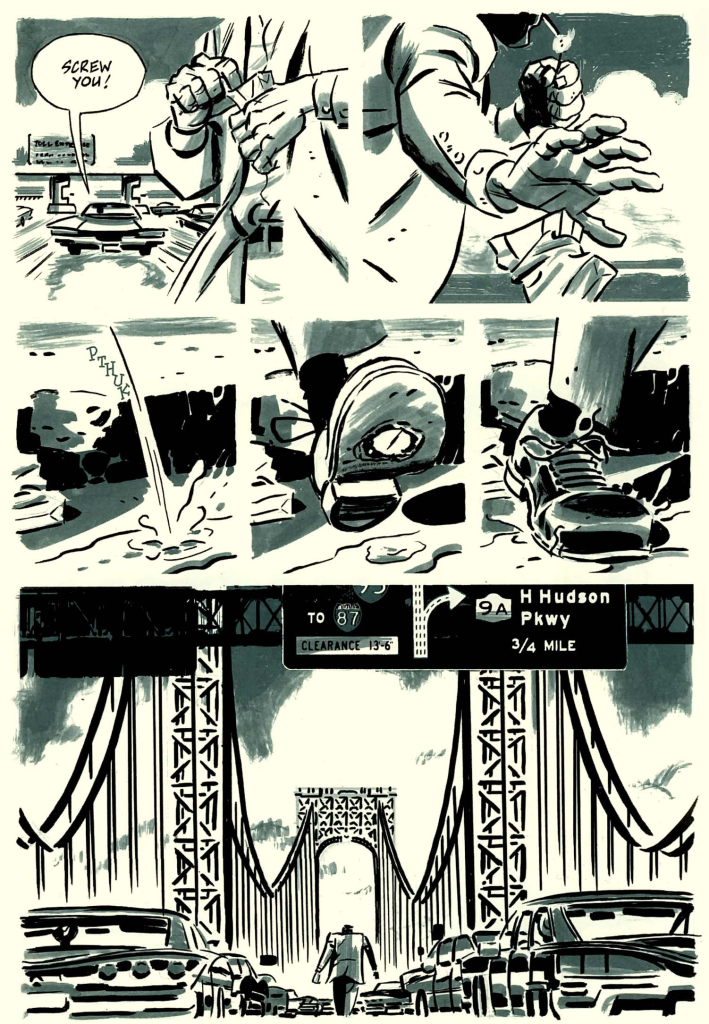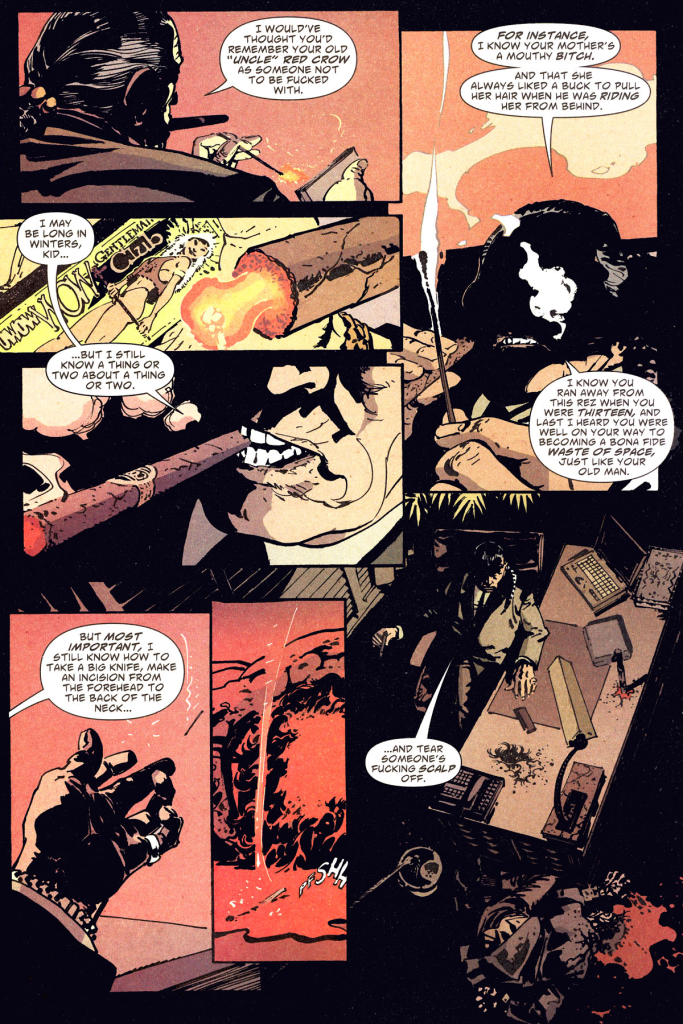If you read the last post, you know what’s going on. Here are another 5 non-superhero crime comics for fans of Batman’s noirish side:
Human Target
 Christopher Chance is a body guard who impersonates his clients, using his skills to pull a fast one on whoever is trying to kill them. There have been plenty of Human Target comics and even a TV show, but the string of awesome stories written by Peter Milligan between 1999 and 2005 stands in a class of its own. The main twist is that, under Milligan, Christopher Chance not only takes over his clients’ looks, but more often than not goes native, inhabiting their personality to such a degree that he forgets who he really is.
Christopher Chance is a body guard who impersonates his clients, using his skills to pull a fast one on whoever is trying to kill them. There have been plenty of Human Target comics and even a TV show, but the string of awesome stories written by Peter Milligan between 1999 and 2005 stands in a class of its own. The main twist is that, under Milligan, Christopher Chance not only takes over his clients’ looks, but more often than not goes native, inhabiting their personality to such a degree that he forgets who he really is.
This concept plays neatly to Peter Milligan’s strengths, since virtually all of his comics are about identity crises. What’s more, Milligan is a master of plotting, pillaging the zeitgeist – from 9/11 to steroids-related sports scandals – and delivering tales that are as entertaining as they are thematically rich. In Human Target, the plots are full of switcheroos, constantly pulling the rug from under everyone’s feet, to the point that readers are usually as confused as the characters themselves about who is who – most of the time it’s not even entirely clear whether we are following Christopher Chance’s adventures or those of his deluded assistant.

 Human Target #1
Human Target #1
Even if you’re not into Peter Milligan’s Batman comics (although you ought to be, with a few exceptions), give this sucker a try, as it’s written with a whole different kind of voice. It’s also more action-based than Milligan’s other – equally brilliant – crime comics, Skreemer and The Extremist. And if this isn’t endorsement enough, bear in mind that the art chores fell upon some of the industry’s greatest talents, namely Edvin Biukovic, Javier Pulido, Cliff Chiang, and Cameron Stewart.
Parker
 You’d think it would be impossible to improve upon Richard Stark’s (née Donald E. Westlake) novels about tough-as-nails career criminal Parker, written as they are in a terse style that perfectly matches the cold-hearted, professional attitude of their protagonist. At the very least, it would be hard to reach the heights of the hypnotic Point Blank, the only creatively successful adaptation of the material. And yet, Darwyn Cooke somehow pulls it off almost flawlessly in this series of graphic novels.
You’d think it would be impossible to improve upon Richard Stark’s (née Donald E. Westlake) novels about tough-as-nails career criminal Parker, written as they are in a terse style that perfectly matches the cold-hearted, professional attitude of their protagonist. At the very least, it would be hard to reach the heights of the hypnotic Point Blank, the only creatively successful adaptation of the material. And yet, Darwyn Cooke somehow pulls it off almost flawlessly in this series of graphic novels.

 The Hunter
The Hunter
You can (and should) say what you want about Darwyn Cooke’s abominable work on the Watchmen prequels, but he is unquestionably one of the medium’s greatest visual storytellers. And here he is completely in his element, telling the kind of story he likes, starring a virile anti-hero, set in a period that merges well with his nostalgic, cartoonish art style – not that Cooke doesn’t take the chance to add different styles to his portfolio, especially in the second book, ‘The Outfit.’ Fans of his amazing Catwoman graphic novel Selina’s Big Score should get a special kick out of this series, as that tale was obviously heavily influenced by Richard Stark’s work.
Scalped
 Much like The Wire, Scalped is one of those critical darlings that manages to live up to the hype. Set in an Indian reservation, this comic is part gangster saga, part undercover cop thriller, part 30-year-old mystery, part casino heist, part social realism, part modern day western. It starts off as merely kick-ass, and then evolves into a sprawling epic about a gallery of fascinating characters.
Much like The Wire, Scalped is one of those critical darlings that manages to live up to the hype. Set in an Indian reservation, this comic is part gangster saga, part undercover cop thriller, part 30-year-old mystery, part casino heist, part social realism, part modern day western. It starts off as merely kick-ass, and then evolves into a sprawling epic about a gallery of fascinating characters.

 Scalped #1
Scalped #1
One of the pleasures of Scalped is watching Jason Aaron grow from a writer who is great at balls-to-the-wall violence and testosterone-fueled dialogue into someone who is just as comfortable writing quietly moving human drama. Meanwhile, the team of artist R.M. Guéra and colorist Giulia Brusco bring in the kind of distinctively gritty, dusty look the comic deserves. It doesn’t get much better than this.
Sin City
 Frank Miller’s early ventures into Batman comics were already informed by hardboiled fiction, but Miller took things to a whole other level with Sin City. It’s as if there was an explosion at the film noir factory. In this series of sweaty pulp-as-hell stories set in the most decadent and crime-ridden town this side of Gotham, you can find pretty much every genre archetype blown up to the point of caricature, from the toughest tough guy (who ends up in the electric chair and needs two rounds of shocks, because just one wouldn’t do the trick) to the femme fatale to end all femme fatales (effectively brought to life by Eva Green in the latest film adaptation).
Frank Miller’s early ventures into Batman comics were already informed by hardboiled fiction, but Miller took things to a whole other level with Sin City. It’s as if there was an explosion at the film noir factory. In this series of sweaty pulp-as-hell stories set in the most decadent and crime-ridden town this side of Gotham, you can find pretty much every genre archetype blown up to the point of caricature, from the toughest tough guy (who ends up in the electric chair and needs two rounds of shocks, because just one wouldn’t do the trick) to the femme fatale to end all femme fatales (effectively brought to life by Eva Green in the latest film adaptation).

 Sin City #1
Sin City #1
Along with the exaggerated, Chandler-on-overdrive prose, Sin City features breathtaking art that masterfully uses negative space. This is Frank Miller-the-artist at the top of his game, confidently controlling the pace of the narrative while providing one powerful visual after another. In later entries, Miller also plays with color, sparsely illustrating specific details, to memorable effect. By the way, I’m restricting this list to comics in English, but if you read French (or if you find a translation in any language you read), there is a Belgian series called Berceuse Assassine which also has a limited color palette and rivals Sin City for the award of noiriest comic of all time.
Stray Bullets
 And then there’s Stray Bullets, the only crime comic that can stand up to Scalped. David Lapham’s opus takes place over 20 years (from the mid-1970s to the mid-1990s) and features a huge cast of quirky characters engaged in all kinds of seamy, illicit, or just plain twisted behavior. Stories do not follow a chronological order, so in theory you can pick up any random issue or book and dive in. They range from more or less self-contained narratives (which are pieces of a larger puzzle, but cool enough on their own) to specific character studies (including the surrealist alter ego of one of the protagonists). Compared to Lapham’s recent output in other comics, which is full of over-the-top violence and frat house attitude, Stray Bullets shows much more restraint and insight into humanity, albeit peppered with dark humor. As for the art, it’s a master class of expressive ‘acting,’ as well as dramatic and comedic timing.
And then there’s Stray Bullets, the only crime comic that can stand up to Scalped. David Lapham’s opus takes place over 20 years (from the mid-1970s to the mid-1990s) and features a huge cast of quirky characters engaged in all kinds of seamy, illicit, or just plain twisted behavior. Stories do not follow a chronological order, so in theory you can pick up any random issue or book and dive in. They range from more or less self-contained narratives (which are pieces of a larger puzzle, but cool enough on their own) to specific character studies (including the surrealist alter ego of one of the protagonists). Compared to Lapham’s recent output in other comics, which is full of over-the-top violence and frat house attitude, Stray Bullets shows much more restraint and insight into humanity, albeit peppered with dark humor. As for the art, it’s a master class of expressive ‘acting,’ as well as dramatic and comedic timing.
 Stray Bullets #10
Stray Bullets #10
Although David Lapham’s Batman-related work is clearly much less heartfelt, you can see some of his genius in City of Crime, an engrossing exploration of the sordid side of Gotham. Don’t take my word for it, just check out what Greg Burgas, one of the keenest comics bloggers out there, wrote about it. Or better yet, read the damn thing yourself.
 Detective Comics #801
Detective Comics #801
NEXT: Batman talks about sex.
